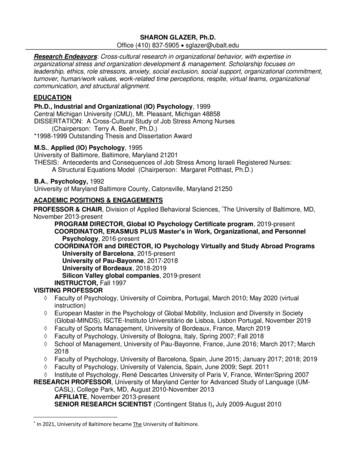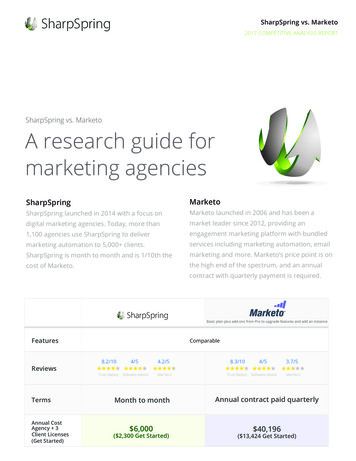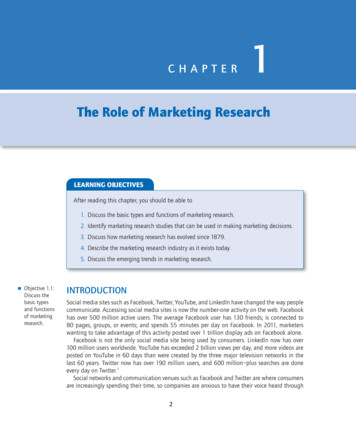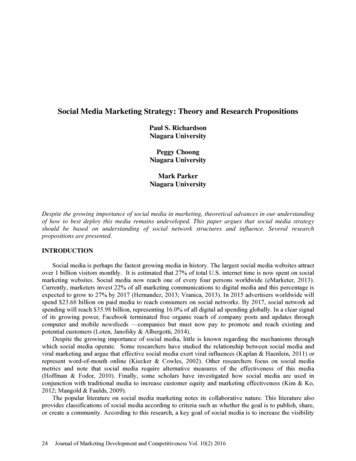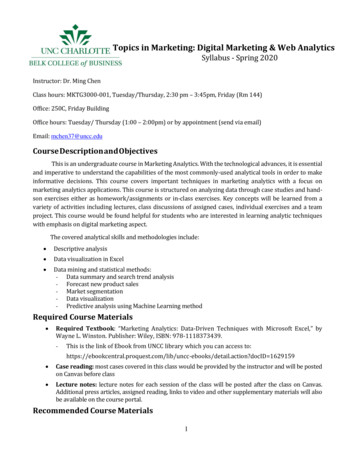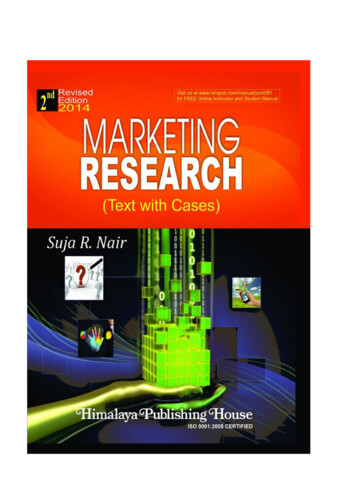
Transcription
An Introduction to Marketing ResearchChapter 1 1
2 Chapter 1M arketing ResearchMarketingResearch(Text with Cases)Suja R. NairB.A. (Hons.), M.B.A.Strategic Marketing ConsultantEDUCE MICRO RESEARCHBengaluru,suja.educe@rediffmail.comSecond Revised Edition: 2014MUMBAI NEW DELHI NAGPUR BENGALURU HYDERABAD CHENNAI PUNE LUCKNOW AHMEDABAD ERNAKULAM BHUBANESWAR INDORE KOLKATA GUWAHATI
Chapter 1 3An Introduction to Marketing Research AuthorNo part of this publication may be reproduced, stored in a retrieval system, or transmitted in any form or by any means,electronic, mechanical, photocopying, recording and/or otherwise without the prior written permission of the publishers.First EditionReprintSecond Revised Edition: 2003: 2005, 2007, 2008, 2009, 2010, 2011: 2014Published by: Mrs. Meena Pandey for Himalaya Publishing House Pvt. Ltd.,“Ramdoot”, Dr. Bhalerao Marg, Girgaon, Mumbai - 400 004.Phone: 022-23860170/23863863, Fax: 022-23877178E-mail: himpub@vsnl.com; Website: www.himpub.comBranch Offices:New Delhi: “Pooja Apartments”, 4-B, Murari Lal Street, Ansari Road, Darya Ganj, New Delhi - 110 002.Phone: 011-23270392, 23278631; Fax: 011-23256286Nagpur: Kundanlal Chandak Industrial Estate, Ghat Road, Nagpur - 440 018.Phone: 0712-2738731, 3296733; Telefax: 0712-2721216Bengaluru: No. 16/1 (Old 12/1), 1st Floor, Next to Hotel Highlands, Madhava Nagar, Race Course Road,Bengaluru - 560 001. Phone: 080-22286611, 22385461, 4113 8821, 22281541Hyderabad: No. 3-4-184, Lingampally, Besides Raghavendra Swamy Matham, Kachiguda,Hyderabad - 500 027. Phone: 040-27560041, 27550139Chennai: 8/2 Madley 2nd street, T. Nagar, Chennai - 600 017. Mobile: 09320490962Pune: First Floor, “Laksha” Apartment, No. 527, Mehunpura, Shaniwarpeth (Near Prabhat Theatre),Pune - 411 030. Phone: 020-24496323/24496333; Mobile: 09370579333L uc k no w: House No 731, Shekhupura Colony, Near B.D. Convent School, Aliganj, Lucknow - 226 022.Phone: 0522-4012353; Mobile: 09307501549Ahmedabad: 114, “SHAIL”, 1st Floor, Opp. Madhu Sudan House, C.G. Road, Navrang Pura,Ahmedabad - 380 009. Phone: 079-26560126; Mobile: 09377088847Ernakulam: 39/176 (New No: 60/251) 1st Floor, Karikkamuri Road, Ernakulam, Kochi – 682011.Phone: 0484-2378012, 2378016; Mobile: 09387122121Bhubaneswar: 5 Station Square, Bhubaneswar - 751 001 (Odisha). Phone: 0674-2532129, Mobile: 09338746007Ind ore: Kesardeep Avenue Extension, 73, Narayan Bagh, Flat No. 302, IIIrd Floor,Near Humpty Dumpty School, Indore - 452 007 (M.P.). Mobile: 09303399304Kolkata: 108/4, Beliaghata Main Road, Near ID Hospital, Opp. SBI Bank, Kolkata - 700 010,Phone: 033-32449649, Mobile: 7439040301Guwahati: House No. 15, Behind Pragjyotish College, Near Sharma Printing Press, P.O. Bharalumukh,Guwahati - 781009, (Assam). Mobile: 09883055590, 08486355289, 7439040301DTP by: SunandaPrinted at: M/s. Charita Impressions, Hyderabad on behalf of HPH.
4 Chapter 1M arketing ResearchPREFACEToday every organization is striving to exist and grow in a world rife with multifacetedchallenges. The biggest challenge before every marketer is to keep oneself constantly updated andexplore on ways to gain insights on the target consumers' and the important marketplace elements.Success at the marketplace is greatly dependent on the extent to which the company is able toconvert the huge information gathered into newer consumer insights which will help them totake better decisions and deliver valuable product and service offerings to their target market. Inorder to create value and build meaningful relationship with their targeted market, marketersneed to constantly re-invent, innovate and communicate about their products and services totheir customers. Living in the digital age with explosion of information technologies, marketershave access to huge amount of marketing information. This mammoth information is generatedby having in place, an effective marketing research and information system.Across the world, markets are going through turbulent changes on account of the recessiongenerally affecting the demand-supply equations. So, it is really a testing period for marketerswho have to identify ways on how to compete in the existing volatile, uncertain, complex,unpredictable and ambiguous marketing environment. In times of such uncertainty, a bigchallenge before the marketer is to transform the vast volume of information generated throughmarketing research activities carried out into meaningful and actionable marketing decisions.Thus, marketing research is a very important area which will help marketers not only to gainfresh consumer insights but also to use the information to create customer value and build strongrelationships with them.This revised second edition of 'Marketing Research' will take you all through to thefascinating field of modern marketing research in an interesting and practical way. This book isdesigned so as to enable the reader to easily grasp and learn the various concepts. Keeping in linewith the broad topics covered in the previous edition, this revised edition takes into considerationcertain new topics such as online/Internet marketing and Rural market research which are foundto be very relevant today.The book is divided into four parts. In the first part, a macro level view of what is marketingresearch, the importance of marketing information and marketing decision support system andthe relevance of the various types of research designs are discussed.The second and third parts takes one through a micro level view of the ways of collectingdata, sampling details and methods of analyzing the data. The discussions in the relevant chapterswith real and practical examples will help all those interested in marketing research to takeeffective decisions in the future either as managers or researchers.In the final part (fourth) of the book, the steps involved in the research process and applicationsof marketing research are discussed. In the last two chapters along with examining the traditionalapplications of marketing research, the currently popular applications such as maintainingdatabase, relationship marketing, brand equity measurement, customer satisfaction, total qualitymanagement, Internet marketing and rural market research are also addressed.
An Introduction to Marketing ResearchChapter 1 5Objectives and specific features of the book:The main objectives and features associated with writing this text book on marketing researchare: To reiterate the importance of gathering marketing information to succeed in the competitiveworld and how this can be used by an organization to take effective decisions. To familiarize all those interested in marketing research, be it today's students or tomorrow'smanagers/researchers with the various steps involved in the marketing research process. Suchlearning will enable them to appreciate the utility of research and take futuristic decisions inan efficient manner. Usage of simple and easy to understand language throughout the book. Adoption of a macro-micro level approach in the coverage of the various topics, concepts anddiscussions pertaining to the field of marketing research. This will help readers to gain aneasy understanding of all that which goes into a practical oriented research process. Most of the important concepts and variables involved in marketing research are explainedciting real and practical examples to facilitate the link with actual situations. Every chapter commences with a real case discussion relevant to the concepts to be discussed inthe chapter. Under 'Chapter questions for discussion', practical oriented exercises are given to enable thereader to get a realistic feel of the picture/situation likely to occur while carrying out a study. Each chapter ends with a real case study from the industry and when efforts are made to seekanswers to the questions provided, the reader will be able to develop good decision makingskills.Suja R. Nair
6 Chapter 1M arketing ResearchACKNOWLEDGEMENTSI appreciate all the feedback and comments received from the students and readers of thefirst edition of this book which inspired in incorporating many ideas into this revised edition. Iwould like to acknowledge all those who have contributed and helped in the writing of thissecond edition of the book.It gives me pleasure to continue to be associated with my publisher, Himalaya PublishingHouse Pvt. Ltd., especially, Mr. Anuj Pandey, Mr. Niraj Pandey and Mr. Vijay Pandey. A specialthank you to them for their valuable suggestions and wholehearted commitment in bringing outthis book. My heartfelt thanks to Mr. Rajesh Naidu, Ms. Nimisha, Mr. Adiga and all the teammembers of the production department at the Himalaya Publishing House Pvt. Ltd., Mumbai fortheir continuous cooperation and support in the development and publication of the book. Iwould also like to express thanks to Mr. Madhu for the DTP and computer support.Finally, and most importantly, I would like to express my sincere appreciation to my familyfor their constant support and encouragement.Suja R. Nair
An Introduction to Marketing ResearchChapter 1 7CONTENTSPart-I: Introduction, Decision Support System and Research DesignCHAPTER - 1: An Introduction to Marketing ResearchlLearning objectiveslIMRB and Nielsen McKinsey’s Research StudieslIntroductionlMeaning and definition of marketing researchlUtility and scope of marketing researchlLimitations of marketing researchlBrief history of marketing researchlEthics in marketing researchlSummarylChapter questions for discussionlSuggested readingslCase: ‘OCM Suiting’ aspiring to change its old world legacyCHAPTER - 2: Information, Decision Support System andMarketing Decision Support SystemlLearning objectiveslProfessor Sheena Iyengar's Experimental StudylIntroductionlMarketing Intelligence SystemlMarketing Information SystemlImportance of Marketing Information System (MIS) and Decision Support System (DSS) in marketingresearchlMarketing Decision Support Systems (MDSS)lSummarylChapter questions for discussionlSuggested readingslCase: The Gold Loan People - Manappuram GroupCHAPTER - 3: Research Design and Marketing Research ProcesslLearning objectiveslIndia's first electric car 'Reva'lIntroductionlMeaning of marketing research designlTypes of research designlExploratory research– Secondary data analysis– Experience surveys– Case study analysis1 - 1617 - 3334 - 69
8 Chapter 1M arketing Research– Focus groups– Projective techniqueslDescriptive research– Cross-sectional studies– Longitudinal studieslCasual ResearchlExperimental designs– Classical designs– Statistical designslThe research processlSummarylChapter questions for discussionlSuggested readingslCase: Dettol SoaplAppendix (Bayesian Analysis)Part-II: Data Collection MethodsCHAPTER - 4: Sources of Information and SecondaryData CollectionlLearning objectiveslGodrej Appliances: 'EON'lIntroductionlMeaning of secondary research datalUsing secondary datalAdvantages of secondary datalLimitations of secondary datalAn Example: A Study to understand the beauty market businesslInternal sources of secondary datalExternal sources of secondary datalSummarylChapter questions for discussionlSuggested readingslCase: Tata SwachCHAPTER - 5: Primary Data CollectionlLearning objectiveslLD2 [Living Digital] Mobile Survey – 2010lIntroductionlSteps involved in primary data collectionlData collection methods for quantitative researchlQualitative research methodslOther non structured research techniques70 - 8788 - 116
Chapter 1 9An Introduction to Marketing ResearchlQuestionnairelSummarylChapter questions for discussionlSuggested readingslCase: The Most Exciting Youth Brands SurveylAppendix 'A' - (Sample Questionnaire)CHAPTER - 6: Sampling, Scaling and Attitude MeasurementlLearning objectiveslTrying to understand the basic attitudes of prospective customers at KitschlIntroductionlBasic terms used for samples and samplinglApproaches or sampling methodslSample size determinationlAttitude measurement and scalinglCriteria for good measurementlTypes of rating scales (basic)lSpecific attitude scales adapted to marketing studieslSummarylChapter questions for discussionlSuggested readingslCase: Is the market for CRT TVs shrinking?117 - 145Part-III: Analyzing DataCHAPTER - 7: Editing, Coding and Tabulation of DatalLearning objectiveslYippee Noodles a success?lIntroductionlAn overview to the fundamentals of processing datalPreparing for data analysis through editinglCodinglTabulation of datalSummarylChapter questions for discussionlSuggested readingslCase: A Model for making affordable sanitary napkinsCHAPTER - 8: Basic Analysis of Data, Cross Tabulationand Hypothesis TestinglLearning objectiveslHonda's 'BRIO' – A premium hatchback built from scratchlIntroduction146 - 161162 - 178
10 Chapter 1lInterrelationship between Analysis and Interpretation activitieslTechniques for analyzing datalSimple statistical summarising techniqueslHypothesis Development and TestinglCross tabulation for data analysislSPSS used for quantitative researchlSummarylChapter questions for discussionlSuggested readingslCase: Shopping trends among Indian shoppersM arketing ResearchCHAPTER - 9: Tests to Analyse DifferenceslLearning objectiveslA comparative study to understand the buying behaviour between urban consumers and ruralconsumerslIntroductionl'Z' and 't' testslSituations Involving 't' TestslOne and two tailed tests and levels of significancelTests for non metric datalChi-square analysislChi-square Contingency tablelMcNemar testlAnalysis of variance (ANOVA)lSummarylChapter questions for discussionlSuggested readingslCase: A study of TV viewership patterns among youngsters in Northern IndiaCHAPTER - 10: Multivariate AnalysislLearning objectiveslCase: Jeeves Consumer Services's ambitious targetlIntroductionlRegression analysislCorrelation analysislMultivariate Regression and CorrelationlSpearman's Coefficient of CorrelationlDiscriminant analysislCluster analysislFactor analysislMultidimensional ScalinglConjoint analysislCriteria for selecting an appropriate statistical test179 - 205206-231
An Introduction to Marketing ResearchlSummarylChapter questions for discussionlSuggested readingslCase: Can “Ray” sway in the scooter market?Chapter 1 11Part-IV: Research Process and Applications of Marketing ResearchCHAPTER - 11: The Research ProcesslLearning objectiveslResearch at P&G, a Creative ApproachlIntroductionlDefining a research problemlMajor seven steps in designing a research projectlCertain principles of report writinglAssessing research proposalslSummarylChapter questions for discussionlSuggested readingslCase: Cinthol in a New Brand PositioningCHAPTER - 12: Traditional Applications ofMarketing ResearchlLearning objectiveslInnovative design of “Gillette Guard” based on product market researchlIntroductionlResearching for new productslResearch for determining pricelAdvertising researchlMarket segmentation and marketing researchlNCAER research to determine income levels and consumer classificationlSummarylChapter questions for discussionlSuggested readingslCase: Brown Tree Chain of Stores - A New ConceptChapter - 13: Popular and Concurrent Applications ofMarketing ResearchlLearning objectiveslMahindra & Mahindra Financial Services (MMFSL) – Customising SolutionslIntroductionlImportance of customer databaselRelationship marketinglBrand equity measurement232 - 244245 - 266267 - 289
12 Chapter 1M arketing ResearchlCustomer satisfactionlSERVQUAL method to measure satisfactionlTotal quality management (TQM)lOnline or Internet marketinglRural market researchlSummarylChapter questions for discussionlSuggested readingslCase: Axis Bank – A Private Bank which Believes in Customer SatisfactionAppendices Selected Statistical TablesAppendix - I: Values of ‘Z’Appendix - II : Critical values of ‘t’Appendix - III : Critical values of Chi-squareAppendix - IV : F distribution (upper 5%)Appendix - V : F distribution (upper 1%)290 - 294
Chapter 1 13An Introduction to Marketing ResearchPart-I: Introduction, Dicision Support System and Research DesignAN INTRODUCTION TOMARKETING RESEARCH1LEARNING OBJECTIVES:After going through the chapter you should be able to: define Marketing Research (MR).analyse the utility and scope of marketing research.examine the limitations of marketing research.give an outline of the history of marketing research.develop an understanding of the ethics involved in marketing research.STRUCTURE: IMRB and Nielsen McKinsey’s Research StudiesIntroductionMeaning and definition of marketing researchUtility and scope of marketing researchLimitations of marketing researchBrief history of marketing researchEthics in marketing researchSummaryChapter questions for discussionSuggested readingsCase: ‘OCM Suiting’ – Aspiring to change its old world legacyInteresting facts about Indian consumers’ shopping habits are revealed by thefollowing two research studies:(A) It was presumed that the opening of large format stores and hybrid supermarketswill inculcate a new pattern of shopping behaviour among consumers. It wasfelt that consumers will make supermarkets the preferred route of consumptionwhen it comes to purchasing daily necessities. However, an IMRB Internationalstudy revealed that the kirana stores dominate grocery purchases. The studyhighlighted that the average Indian consumer prefers to make everyday necessarypurchases from the neighbourhood kirana or mom-and-pop stores. However,with the emergence of a faster and greater number of supermarkets in SouthernIndia, people adapted to this style of buying faster than consumers across othermarkets. Apart from the manner in which one buys, the study also revealed that(13)IMRB & NielsenMcKinsey’sresearch studies
14 Chapter 1M arketing Researchdifferent brands are consumed differently in different parts of the country. Forinstance, the study stated that Britannia was the top of the list of the favouritefood brand in the South and East, with 32 per cent of the respondents voting forit. Parle was the strongest brand in the West, whereas, the two competed neck-toneck in the North. Further, the Amul brand came in at a distant third positionwith 13 per cent.(B) A study was carried out by NM Incite, a Nielsen/McKinsey Company to analysehow social media conversations among Indians can affect online retailing andthe buying behaviour of consumers. It was revealed that consumer conversationson social media are effective predictors of where the future lies. With e-commerceacquiring greater social media clout, the latter was soon being seen as an anchorwhich can trigger the onset of more social commerce across categories. Thestudy indicated that deals on e-commerce site gets shared and re-tweeted onsocial media. This generated a lot of talk about these brands on social media.For instance, travel websites depend on the social media fans to further reachout to the online target consumers. Thus, the research study suggested howsocial network sites are extending into the e-commerce space in order to utilisethe power of individual influence and micro networks. The study added thatthis global trend was visible in group buying sites like fashionandyou snapdeal,deals and you and trades which are attracting a new category of e-shoppersthrough the power of referral. Thus, the study indicates that there is scope forgroup buying among Indian consumers also.INTRODUCTIONThe above two examples show how studies in the marketing area can play an importantrole in gathering information on issues related to taking different decisions. Marketing is a veryessential function of every business organisation. In order to survive in the existing highlycompetitive environment, marketers need to have access to vital information on the changingconsumer needs, competitors’, moves etc. This can be taken care of by investing in MarketingResearch which will not only provide the necessary information but also aid the decisionmaking process.The chapter had commenced with a brief explaination on how two research studies helpedto analyse the market. Now we continue with defining and explaining the meaning of the term,Marketing Research. Then we will examine the utility and scope of marketing research.Thereafter, we will discuss the limitations associated with marketing research. The chapterconcludes with a brief discussion on the history of marketing research and the ethics involvedin marketing research in India.MEANING AND DEFINITION OF MARKETING RESEARCHBefore going into the definition of Marketing Research, let us briefly examine the meaningof the terms ‘Research’ and ‘Market Research’. Simply stated ‘Research’ refers to the processof collecting, documenting and analysing important, critical and relevant information pertainingto any problem or question. This means that the presence of a problem or query or questionimplies research is to be undertaken.Thus, Research connotes a thorough, objective and systematic investigation of a subjector problem in order to uncover the relevant information. Here again, research can be said to beeither “Pure” or “Applied” in nature. Pure research is sometimes referred to as “Fundamental”
An Introduction to Marketing Researchor “Basic research” also. This research is done on an ongoing basis to increase its existingknowledge base in a particular area, not necessarily an immediate solution to an existingproblem. For instance, this research method would be able to predict what Indian consumersmay like to wear after, say ‘x’ number of years. Another example of basic research can berelated to Prof. Arun Kumar’s (Economics Professor of Jawaharlal Nehru University) study onthe Black Economy of India or the National Council of Applied Economic Research’s (NCAER)study on the super rich.Applied research tries to use the existing information to solve a problem or provide thesolution to gain a marketing edge over competitors. For instance, data base on existing creditcard users can be used to work out inputs on additional benefits that can be extended tothem. This can prove to be the starting point for the planning and development of the ‘add ons’for credit card users.As the cliche goes, ‘knowledge is power’. In India, the knowledge boom is a fallout of thepost-liberalisation age. Indian marketers have realised that being information savvy and theneed to get a better fix on the demand supply equations which drive the markets is veryimportant to gain that cutting edge over competitors. This means that in marketing, theemphasis is going to be on applied research. Thus, a very useful definition of Marketingresearch is :Marketing Research is the systematic and objective search for and analysis of informationrelevant to the identification and solution of any problem in the field of marketing.(Burns & Bush, 2009)Marketing Research is a systematic and objective search because careful planningstarting with a clear and concise statement of the problem to be researched, to the objective- (scientific method of marketing) collecting and finally, analysing of information is to be carefullyplanned and worked out.The term “Problem” is used in a broad context and need not indicate that something iswrong. It could be referred to as an eye opener and is an integral part of this information boom.The information unfolded can help them to keep tabs on all sorts of data (sometimes maybeunrelated products) to figure out how their consumers think and behave.UTILITY AND SCOPE OF MARKETING RESEARCHPost liberalisation and with the integration of the Indian industry with the global economy,the customers have also become more aware, demanding and sophisticated. With the adventof e-commerce and the disappearance of trade barriers, marketing firms need to stretchthemselves in order to reach out to customers.Exposure to global competition has ensured that the Indian consumer has developed agreater awareness of international lifestyles and views resulting in a clash between Indian andforiegn brands. Further, with the disappearance of trade barriers, customers no longer preferlocal brands. She has learned to appreciate the ‘quality aspect’ of the brand more than thecost. This means organisations have to vigourously invest in marketing research and buildbrands that are acceptable to the Indian consumer. Thus, it can be seen that marketingresearch will continue to play an important role in the decision making process of a marketingmanager.The utility and scope of marketing research can be examined by having a look at thereasons why organisations are required to carry out researches.Chapter 1 15
16 Chapter 1M arketing Research(a) When organisations get evolved and start growing and expanding theirmarkets, marketers need to keep in touch with the final customers who arefar away from the manufacturer.(b) Organisations and marketing managers need to have exact information onthe target customers’ unmet needs, deliver products and services effectivelyand carry out activities which will add to customer satisfaction and delight.Typically, organisations in the normal course of business, distribute their productsthrough various channels of distribution and so have little direct contact with the finalconsumers. Hence, such organisations make use of marketing research to gatherinformation and knowledge about their customers needs, attitudes, opinions (orfeedback), preferences etc. There are many areas in marketing, where marketingmanagers require different kinds of information in order to be able to satisfy customers’wants as well as design suitable marketing programmes better than competitors.These areas include:1. Gathering all relevant information related to the target market, i.e., identify themost suitable target market, its size, its demographic profiles, etc.2. Collecting information with relevance to the products or services, i.e., howsatisfied or dissatisfied are the target market with the existing products andservices, the desired product features and attributes being sought by consumersand so on.3. Gathering information related to the price value assumed by the targetconsumers. What are the consumers’ opinion on the price of the existingproducts? Do they feel that they have received the value for the price paid forthe product?, and so on.4. To find out the most preferred channel of distribution by the target market. Arethe customers satisfied with the existing channel of distribution? Will theorganisation’s pricing policy be in line to what the target market expects to payfor using the particular channel and so on.5. Collect information on working out the various vehicles of promotion to be usedby the organisation. Ascertain which promotional vehicle will appeal to the targetmarket? When and where to use each promotional tool? and so on.(c) Marketing research during the organisation’s administrative process:Marketing research can also help managers during the various phases of theadministrative process. The main four phases of the administrative process wheremanagers can make use of marketing research are:Phase 1: Setting goals and establishing strategies: When managers are attempting todecide upon a new strategy to be pursued, then marketing research will help togenerate the necessary information. For instance, changes in the media trends,such as more preference for interactions with customers signaled the emergenceof an opportunity to many of the entertainment channels to be involved ininteractive programme sessions with their target audience. This is seen in thereality programmes being telecast on the various T.V. entertainment channels.In the same way, (change in needs, wants and/or) unhappiness (ordissatisfactions) in certain market segments, etc., can indicate that a problemexists and needs to be solved.Phase 2: Developing a marketing plan: For developing marketing plans, managers makeuse of marketing research to identify key market segments. Marketing researchcan help managers to identify important product attributes and advertisingconsiderations to be included in their marketing plans. It will help them to workout suitable marketing plans to tap an emerging market. For instance in ecommerce business, Amazon has established itself as the leader in online
Chapter 1 17An Introduction to Marketing Researchretailing in the U.S and has been interested in entering a large emerging marketlike India. Research indicated that with broadband reaching only two to five percent of Indians, the potential of online retailing is very large here. Having solidlogistics network suitable in an emerging market like India is to be worked out.Since the target market is varied, amazon.com will have to decide on a marketingplan on how to provide technology assisted shopping experience to theircustomers in India.Phase 3: Put the plan into action: When putting a marketing plan into action, themanagement will need to use marketing research to measure and analyse theeffectiveness of the programme. For instance, before the launch of Tata Nano,Tata Motors had carried out a detailed marketing research, which identified theneed of a new ‘Ultra Low Cost” (ULC) car segment across many global countries(markets) and accordingly planned, developed and launched the Nano CarPhase 4: Evaluating the effectiveness of the plan: The information received throughmarketing research can be used by managers to evaluate the effectiveness ofthe plan. These could include measuring: brand awareness, trial rates, repeatpurchase traits, customer satisfaction etc.Keep in touch with customer who are not indirect contact with the manufacturerMarketing Researchhelps to:Gather exact information on target customers’unmet needs and to offer suitable product andservices to satisfy the sameDesign suitable marketing programmesbetter than competitorsFacilitate and aid managers during the variousphases of the administrative processTrack problems and tak
certain new topics such as online/Internet marketing and Rural market research which are found to be very relevant today. The book is divided into four parts. In the first part, a macro level view of what is marketing research, the importance of marketing information a



